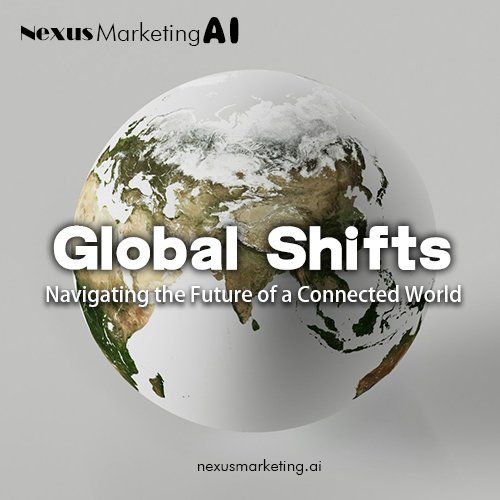Explore how globalization and innovation help companies stay competitive, driving business success in an increasingly connected world.
Global Shifts
Navigating the Future of a Connected World
As the world becomes more interconnected, the forces driving globalization have far-reaching impacts on economies, businesses, and societies. This series dives deep into the core elements shaping today’s global landscape, from technological innovation and economic integration to cultural exchange and environmental sustainability.
Through a comprehensive exploration of these topics, “Global Shifts” offers thought-provoking insights into how businesses can adapt to this rapidly changing environment. Whether you’re a leader aiming to stay ahead of global trends or a professional seeking to understand the shifting dynamics of global trade, this series provides the essential knowledge to navigate the future of globalization.
Series
- Episode1.Globalization 101: Understanding the Basics
- Episode2.Economic Globalization: Trade and Investment Flows
- Episode3.Technological Globalization: The Role of Digitalization
- Episode4.Cultural Globalization: Cross-cultural Exchange and Influence
- Episode5.Political Globalization: Global Governance and Multilateralism
- Episode6.Sustainability in Globalization: Environmental Impact and Solutions
- Episode7.Global Supply Chains: Challenges and Opportunities
- Episode8.The Future of Globalization: Trends and Predictions
- Episode9.Challenges of Globalization: Inequality and Social Impacts
- Episode10.Globalization and Innovation: How Companies Stay Competitive
Table of Contents

Prefer to listen? Enjoy the audio version of this article
Curated audio version | Audio powered by AI
Innovation as the Driver of Global Competitiveness

In an increasingly interconnected world, innovation has become the cornerstone of competitiveness. Companies that embrace new technologies, creative business models, and sustainable practices are better positioned to succeed in the global marketplace. As globalization intensifies competition across industries, staying ahead requires a relentless focus on innovation—whether through digital transformation, leveraging global talent, or adapting to shifting consumer demands.

The Role of Innovation in the Global Economy
Innovation is the driving force behind the rapid economic growth seen in many sectors. It enables companies to develop new products, improve operational efficiency, and adapt to ever-changing market conditions. In a globalized economy, innovation is not just a differentiator—it is essential for survival. Companies that fail to innovate risk being left behind as competitors from around the world introduce disruptive technologies, leaner processes, and more sustainable practices.
Innovation fosters productivity, allowing businesses to optimize resources, reduce costs, and enhance their value proposition. For multinational corporations (MNCs), global innovation ecosystems provide access to diverse talent, emerging technologies, and new ideas. By integrating innovation into their core strategies, companies can enhance their competitiveness, enter new markets, and sustain long-term growth.

The Challenges of Staying Competitive in a Globalized World
While globalization opens up vast opportunities, it also creates significant challenges for companies seeking to maintain a competitive edge. The rapid pace of technological change, combined with the rise of new players in emerging markets, has intensified competition. In addition, global companies must navigate diverse regulatory environments, adapt to different cultural contexts, and respond to fluctuating market demands.
One of the key challenges is the speed at which innovation cycles are shrinking. Products that once had long market lifespans are now being replaced more quickly as new technologies emerge. To stay competitive, companies must not only innovate but also do so with agility and speed. Additionally, the pressure to innovate sustainably—balancing profitability with environmental and social responsibility—has become a major priority for companies operating in the global marketplace.
Embracing Digital Transformation

Digital transformation has become a critical factor for companies looking to maintain their competitive edge in a globalized world. As technological advancements reshape industries, businesses must adopt digital tools and strategies to enhance efficiency, streamline operations, and meet evolving customer demands. From automation to artificial intelligence, digital technologies are empowering companies to innovate more rapidly and effectively than ever before.

The Impact of AI and Automation
Artificial intelligence (AI) and automation are at the forefront of the digital revolution, transforming industries ranging from manufacturing to finance. AI enables companies to analyze vast amounts of data, automate decision-making processes, and improve customer experiences. Automation, particularly in manufacturing and logistics, has led to greater efficiency, reduced costs, and faster production cycles.
For example, AI-powered algorithms can predict consumer behavior, optimize supply chains, and personalize marketing strategies, giving businesses a competitive edge in targeting the right customers at the right time. Meanwhile, automation technologies, such as robotics and machine learning, are allowing companies to streamline labor-intensive tasks, reducing human error and lowering operational costs.
However, while AI and automation can boost productivity, they also present challenges. Companies must carefully manage the transition to ensure that employees are not left behind. Upskilling and reskilling programs are essential to prepare the workforce for the changing nature of work in an AI-driven economy. Those that successfully integrate AI and automation into their business models will position themselves as leaders in their industries.

Cloud Computing and Data Analytics
Cloud computing has revolutionized how businesses operate by providing scalable, cost-effective, and flexible access to data and applications. Companies can now store and process vast amounts of information without the need for expensive infrastructure, enabling them to scale quickly and efficiently across global markets. This shift to cloud-based services has unlocked new opportunities for collaboration, innovation, and data-driven decision-making.
Data analytics plays a critical role in turning raw data into actionable insights. With the help of advanced analytics tools, companies can make more informed decisions about everything from product development to marketing strategies. By harnessing the power of big data, businesses can identify trends, anticipate customer needs, and respond to market shifts with greater agility.
Companies that embrace cloud computing and data analytics are better equipped to innovate, optimize their operations, and remain competitive in a rapidly changing global environment.

Cybersecurity as a Competitive Necessity
As companies undergo digital transformation and rely more on technology to drive their operations, cybersecurity has become a critical concern. The increasing use of cloud services, AI, and data analytics has exposed businesses to new vulnerabilities, including cyberattacks, data breaches, and intellectual property theft. In this environment, robust cybersecurity measures are not just a protective measure—they are a competitive necessity.
Consumers and business partners are increasingly prioritizing security when choosing who to work with. Companies that can demonstrate strong cybersecurity practices, such as data encryption, multi-factor authentication, and regular security audits, are more likely to gain the trust of their clients and customers. Furthermore, adhering to international cybersecurity standards and regulations helps companies avoid costly fines, legal complications, and reputational damage.
As digital transformation accelerates, companies that invest in comprehensive cybersecurity strategies will not only protect their assets but also gain a competitive edge in a market that values trust and data integrity.
Leveraging Global Talent and Collaboration

In the globalized economy, talent and collaboration are key drivers of innovation. As digital tools break down geographical barriers, companies can access diverse talent pools and foster international partnerships that enhance creativity and problem-solving. Leveraging global talent and forming strategic collaborations allow businesses to stay competitive by tapping into new ideas, expertise, and markets.
Remote Work and Global Talent Acquisition
The rise of remote work, accelerated by the COVID-19 pandemic, has transformed how companies access talent. No longer confined to local or regional labor markets, businesses can now recruit skilled professionals from around the world. This shift allows companies to bring together diverse teams with different perspectives, skills, and cultural backgrounds, fostering innovation and creating competitive advantages.
By embracing remote work, companies can overcome talent shortages in certain regions and reduce operational costs associated with maintaining large physical offices. Furthermore, the ability to hire globally enables businesses to operate 24/7 across multiple time zones, enhancing productivity and customer service.
However, managing remote teams also presents challenges, including communication barriers, time zone differences, and maintaining company culture. To maximize the benefits of global talent acquisition, companies must invest in digital collaboration tools, clear communication strategies, and strong leadership to ensure that remote teams remain connected and productive.

Strategic Partnerships and Global Collaboration
Strategic partnerships with other businesses, research institutions, and industry organizations have become essential for driving innovation in a globalized market. By collaborating with partners across borders, companies can share resources, knowledge, and expertise, accelerating research and development efforts and bringing new products to market more quickly.
Global collaboration is particularly important in sectors like technology, healthcare, and clean energy, where innovation often requires interdisciplinary approaches and large-scale investment. For instance, pharmaceutical companies frequently partner with academic institutions and governments to develop new treatments and vaccines, combining their respective strengths to achieve breakthroughs that would be difficult to achieve alone.
Strategic partnerships can also help companies enter new markets by leveraging local expertise and networks. By collaborating with local firms or startups, multinationals can navigate regulatory environments, understand consumer preferences, and adapt their products and services to regional needs.

The Role of Cross-cultural Competence
As companies engage in global collaborations and work with international teams, cross-cultural competence becomes a vital skill. Cross-cultural competence refers to the ability to understand, communicate, and work effectively with individuals from different cultural backgrounds. It enhances team dynamics, reduces misunderstandings, and improves decision-making in global business contexts.
Cultural differences can impact everything from communication styles and decision-making processes to attitudes toward hierarchy and risk-taking. Companies that prioritize cross-cultural training for their employees are better equipped to navigate these differences and foster a more inclusive, creative, and productive working environment.
In a globalized world, businesses that embrace cultural diversity and promote cross-cultural competence within their teams will be more agile and innovative, giving them a competitive edge in international markets.
Sustainable Innovation in a Globalized Market

As environmental concerns and consumer expectations grow, sustainability has emerged as a core component of innovation. Companies are increasingly looking for ways to integrate sustainable practices into their operations and product development, not only to meet regulatory requirements but also to gain a competitive edge in the marketplace. Sustainable innovation is now driving business strategies across industries, helping companies reduce their environmental footprint while maintaining profitability.

The Rise of Green Technologies and Sustainable Business Models
Green technologies are playing a critical role in transforming industries toward sustainability. From renewable energy solutions to energy-efficient manufacturing processes, businesses are adopting new technologies that minimize environmental harm while enhancing long-term sustainability. Solar power, wind energy, electric vehicles, and advanced recycling techniques are just a few examples of innovations that are reshaping global markets.
Companies that invest in green technologies are not only reducing their carbon footprint but also gaining a competitive advantage. Consumers are increasingly prioritizing sustainability, and businesses that align with these values are better positioned to attract environmentally conscious customers. For example, companies like Tesla and Siemens have built their brands around sustainability and innovation, using green technology as a key differentiator in their respective markets.

Circular Economy and Resource Efficiency
The concept of the circular economy, where resources are reused, repaired, or recycled instead of being discarded, is gaining traction globally. In contrast to the traditional linear economic model—where products are made, used, and disposed of—a circular economy focuses on reducing waste and maximizing the use of resources. This shift is driving companies to rethink their supply chains, product designs, and manufacturing processes.
By embracing circular economy principles, businesses can lower production costs, reduce waste, and increase resource efficiency. For instance, companies in the fashion industry are developing clothing lines made from recycled materials, while tech firms are exploring ways to design products that are easier to repair and recycle. These practices not only help businesses operate more sustainably but also foster innovation by encouraging the development of new materials and processes.
Circular economy models also allow companies to build stronger relationships with consumers by offering services like product repair, refurbishment, or recycling, which extend the lifecycle of their products. This shift toward resource efficiency can become a key competitive advantage for companies that are looking to differentiate themselves in the global market.

Environmental Regulations and Global Standards
As governments around the world tighten environmental regulations, companies must adapt to meet stricter sustainability standards. From carbon emission limits to waste management requirements, businesses are increasingly being held accountable for their environmental impact. Navigating these regulations requires innovation, as companies must develop new technologies, processes, and strategies to remain compliant while maintaining profitability.
Global standards such as the Paris Agreement on climate change are driving countries to adopt policies that encourage sustainable business practices. Companies that proactively address environmental concerns are better positioned to comply with international regulations, avoid fines, and enhance their reputation in the global marketplace. Moreover, businesses that lead the way in sustainability can influence the regulatory environment, helping shape future policies that support green innovation.
By aligning their business models with environmental goals, companies can turn regulatory challenges into opportunities for innovation and growth. Those that stay ahead of the curve in terms of sustainability will not only meet the expectations of governments and consumers but also set new benchmarks for their industries.
Adapting to Shifting Consumer Demands

As globalization has expanded market access and competition, consumer preferences have evolved dramatically. Today’s consumers expect more personalized experiences, faster service, and greater transparency from the brands they interact with. Companies must stay attuned to these shifting demands and innovate to keep pace with changing market expectations. Those that fail to adapt risk losing their competitive edge, while those that embrace these changes can gain loyalty and increase market share.

Customization and Personalization in the Digital Age
In the era of digital transformation, customization and personalization have become key drivers of consumer satisfaction. Modern consumers expect brands to offer products and services tailored to their specific preferences, whether it’s personalized recommendations, bespoke products, or targeted marketing campaigns. This shift has been made possible by the rise of digital tools like data analytics, artificial intelligence (AI), and machine learning, which allow companies to gather insights into individual consumer behaviors and preferences.
For example, companies like Amazon and Netflix use AI-powered recommendation engines to suggest products and content based on users’ past interactions. This level of personalization creates a more engaging and relevant customer experience, increasing loyalty and driving higher sales. Similarly, in industries such as fashion and consumer electronics, customization options—like made-to-order clothing or personalized device configurations—have become powerful differentiators.
By adopting digital tools and focusing on personalization, companies can enhance their customer relationships and create more meaningful interactions, ultimately gaining a competitive advantage in the global marketplace.

Speed and Agility: Meeting Consumer Expectations
In today’s fast-paced world, speed and agility are critical for meeting consumer expectations. Instant gratification has become the norm, with consumers demanding faster delivery times, quicker response rates, and seamless interactions across multiple channels. E-commerce giants like Amazon have set the standard for rapid fulfillment, with same-day or next-day delivery becoming the expected norm in many regions.
To remain competitive, companies must optimize their supply chains, logistics, and customer service operations to provide faster, more responsive services. This may involve adopting technologies such as automated warehousing, AI-driven demand forecasting, and real-time inventory management systems to streamline operations and reduce delivery times.
Being agile in responding to market changes is also essential. Companies must be able to pivot quickly to adapt to new trends, consumer preferences, and market disruptions. Whether it’s launching new products, entering new markets, or adjusting business strategies, agility enables companies to remain relevant and competitive in an ever-changing global landscape.

Ethical Consumerism and Transparency
As consumers become more socially and environmentally conscious, they are increasingly choosing brands that align with their values. Ethical consumerism—where purchasing decisions are influenced by a company’s stance on sustainability, human rights, and corporate responsibility—has gained significant momentum. Consumers are demanding greater transparency from businesses regarding their supply chains, sourcing practices, labor conditions, and environmental impact.
Companies that prioritize ethical practices and openly communicate their efforts to address social and environmental issues are more likely to build trust and loyalty with consumers. For example, brands like Patagonia and Ben & Jerry’s have built strong reputations by committing to sustainability, social justice, and ethical sourcing. Their transparency and ethical approach have not only resonated with consumers but also helped them differentiate themselves in crowded markets.
To stay competitive, companies must integrate sustainability and transparency into their core business strategies. Providing clear, verifiable information about their practices and demonstrating a commitment to ethical values will help businesses meet the expectations of today’s conscious consumers and succeed in a rapidly evolving global marketplace.
The Role of Startups and Disruptive Innovation

In the globalized economy, startups and small businesses play a pivotal role in driving disruptive innovation. Unlike larger corporations, startups can often move quickly, taking risks and experimenting with new ideas that challenge the status quo. Disruptive innovation reshapes industries, creating new markets and displacing established players. As a result, established companies must constantly learn from these emerging innovators to stay competitive.

How Startups Drive Disruption in Global Markets
Startups are known for their ability to think outside the box, developing innovative solutions that address unmet needs or improve upon existing products and services. By focusing on niche markets, using lean business models, and adopting cutting-edge technologies, startups have the agility to disrupt traditional industries. For example, companies like Uber and Airbnb transformed transportation and hospitality by creating entirely new business models that leverage digital platforms to connect consumers with services.
Startups often prioritize innovation over profitability in their early stages, which allows them to focus on developing groundbreaking products without the constraints of short-term financial pressures. This freedom to innovate gives startups the ability to rapidly adapt to changing consumer preferences, technology trends, and market conditions, positioning them as powerful disruptors in the global economy.
Established companies can benefit from keeping a close eye on startups, as these emerging players often highlight shifts in market demand, technological advances, or evolving consumer expectations. Collaborating with or investing in startups can also provide established firms with access to fresh ideas, talent, and disruptive technologies.

Innovation Hubs and Ecosystems
The rise of innovation hubs and ecosystems around the world has fueled the growth of startups and disruptive innovation. Cities like Silicon Valley, London, Berlin, and Shenzhen have become centers for entrepreneurial activity, attracting venture capital, skilled talent, and research institutions. These hubs provide startups with access to resources, networks, and investment opportunities that are essential for scaling their innovations.
Innovation ecosystems often include accelerators, incubators, and co-working spaces that support the growth of early-stage startups by providing mentorship, funding, and access to markets. These ecosystems foster collaboration between startups, corporations, and academic institutions, allowing for cross-pollination of ideas and technologies. Startups can leverage these ecosystems to test new concepts, refine their business models, and gain traction in global markets.
For established companies, participating in innovation hubs allows them to stay connected to the latest trends and tap into emerging technologies. Many corporations have set up innovation labs or venture arms in these hubs to collaborate with startups, enabling them to remain at the forefront of industry innovation.

Learning from Disruptors: Lessons for Established Companies
Established companies can learn valuable lessons from the agility and innovation of startups. While large organizations often have more resources and market influence, they can be slow to adapt to new trends or disruptions. By adopting a startup mindset—embracing risk-taking, encouraging creativity, and maintaining a flexible business model—larger companies can become more innovative and responsive to market changes.
Corporate innovation initiatives, such as internal incubators or partnerships with startups, allow established firms to test new ideas in a low-risk environment. Additionally, fostering a culture of continuous learning and experimentation can help companies stay competitive in the face of disruption. By learning from the successes and failures of startups, larger businesses can stay nimble and ensure they remain relevant in the rapidly evolving global market.
The Future of Innovation in Globalization

As globalization continues to evolve, innovation remains the key to staying competitive in a rapidly changing world. Companies that embrace technological advancements, sustainable practices, and global collaboration are better positioned to thrive in this dynamic landscape. Innovation is no longer an option but a necessity for businesses to differentiate themselves and succeed in an increasingly interconnected global market.
Innovation as a Continuous Process
Innovation is not a one-time effort—it is an ongoing process that requires companies to continuously adapt to new technologies, shifting consumer demands, and emerging market opportunities. The companies that succeed in the global economy are those that foster a culture of continuous improvement and experimentation. By investing in research and development, embracing disruptive technologies, and remaining open to new ideas, businesses can stay ahead of the curve and maintain their competitive edge.
To sustain innovation over the long term, companies must also build the infrastructure and resources needed to support it. This includes developing internal capabilities, such as data analytics and digital transformation, as well as external collaborations with startups, research institutions, and global partners. By creating a strong foundation for innovation, businesses can weather market disruptions and capitalize on new opportunities.

The Role of Globalization in Shaping Future Innovation
Globalization has accelerated the pace of innovation by breaking down barriers to trade, knowledge sharing, and collaboration. As companies operate in a more interconnected world, they have access to a diverse range of talent, technologies, and markets that fuel innovation. However, globalization also brings challenges, such as increased competition, regulatory complexities, and environmental pressures.
In the future, successful companies will be those that navigate these challenges by embracing globalization while staying true to their core values. This means balancing global growth with local responsiveness, adopting sustainable business practices, and continuously innovating to meet the needs of a rapidly changing world. The ability to innovate across borders—whether through digital platforms, global talent acquisition, or cross-cultural collaboration—will be the defining feature of companies that lead in the global economy.
This concludes the final episode of the series. The exploration of how globalization and innovation intertwine has highlighted the critical importance of staying competitive through continuous learning, collaboration, and adaptation. Thank you for following the series.

Global Shifts: Navigating the Future of a Connected World
FAQs
-
How does globalization drive innovation in companies?
Globalization drives innovation by exposing companies to new markets, diverse consumer needs, and international competition. This pressure encourages businesses to innovate, develop new products, and adopt cutting-edge technologies to stay competitive. Access to global talent, resources, and collaborative opportunities further accelerates the innovation process.
-
What role does digital transformation play in global business competitiveness?
Digital transformation plays a crucial role in enhancing global business competitiveness by optimizing operations, improving customer experience, and enabling data-driven decision-making. Technologies such as AI, cloud computing, and automation help companies streamline processes, reduce costs, and respond quickly to market changes, making them more agile and competitive on a global scale.
-
How do companies leverage global talent to boost innovation?
Companies leverage global talent by building diverse teams that bring unique perspectives and expertise. Remote work, international hiring, and collaboration with global research institutions allow businesses to access a broader talent pool, fostering creativity and innovation. Multinational teams can better understand regional markets and adapt products to meet local needs.
-
What are the benefits of forming strategic partnerships in a globalized market?
Strategic partnerships in a globalized market allow companies to share resources, reduce costs, and access new technologies and markets. Collaborating with other firms, startups, or academic institutions can accelerate research and development, drive innovation, and improve product offerings. Partnerships also help companies navigate complex regulatory environments and enhance their global reach.
-
How do sustainability and innovation intersect in globalization?
Sustainability and innovation intersect as companies seek to reduce their environmental footprint while staying competitive. Green technologies, such as renewable energy, sustainable materials, and circular economy models, enable businesses to innovate in ways that meet global environmental standards. This focus on sustainable innovation helps companies build a positive brand image and meet the growing demand for eco-friendly products.
-
What challenges do companies face when trying to innovate globally?
Companies face several challenges when innovating globally, including cultural differences, regulatory complexities, and supply chain disruptions. Adapting products and business models to diverse markets requires understanding local consumer behavior and regulatory standards. Additionally, maintaining data security and protecting intellectual property in a globalized digital landscape can be complex.
-
How does the rise of startups influence global competition?
Startups influence global competition by driving disruptive innovation and challenging established companies with new business models and technologies. Their agility and willingness to take risks allow them to quickly adapt to market needs and introduce groundbreaking products. Established companies often learn from or partner with startups to stay ahead of market trends and maintain competitiveness.
-
How important is cross-cultural competence for global innovation?
Cross-cultural competence is essential for global innovation as it enables companies to understand and respect cultural differences, fostering better collaboration within multinational teams. This competence helps in developing products that resonate with diverse consumer bases and facilitates smoother operations across different markets. Companies that prioritize cross-cultural understanding are better equipped to innovate effectively on a global scale.
-
How can companies use data analytics to stay competitive in a global market?
Data analytics helps companies stay competitive by providing insights into market trends, consumer behavior, and operational efficiency. By analyzing large datasets, companies can make informed decisions, predict market shifts, and personalize their offerings to meet customer needs. Data-driven strategies enable businesses to optimize marketing, enhance supply chain management, and innovate with precision.
-
What are the future trends in globalization and innovation for companies?
Future trends in globalization and innovation include the increased use of AI and machine learning, growth in digital trade, and a stronger focus on sustainability. Companies will need to embrace these technologies, adopt agile business models, and prioritize ethical and sustainable practices to thrive in an evolving global market. Additionally, geopolitical shifts and changes in consumer expectations will continue to shape the landscape of global business innovation.














